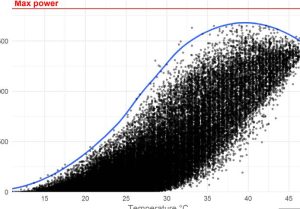How Does Temperature Affect Solar Panel Efficiency?
It's a blazing hot day, and you're basking in the sunshine, grateful for the solar panels on your roof that are hard at work. But here's a twist: as the mercury rises, the efficiency of those solar panels begins to dip. This might seem counterintuitive. After all, more sun means more energy, right? Not quite. Let's dive into the fascinating dynamics between temperature and solar panel performance, shedding light on why cooler might actually mean more power.

The Science Behind the Heat
At the heart of this phenomenon is a little something called the temperature coefficient. This coefficient measures the impact of temperature changes on solar panel efficiency. For most solar panels, efficiency decreases as the temperature goes up. The reason lies in the physics of solar cells. As temperature increases, the semiconductor material in the solar cells gets excited and generates more energy carriers. While this might sound like a good thing, it actually leads to less efficient energy conversion.
Crunching the Numbers: Efficiency Takes a Hit
Let's talk specifics. The average temperature coefficient for silicon solar panels ranges from -0.3% to -0.5% per degree Celsius. This means that for every degree above 25°C (77°F), the panel's efficiency decreases by 0.3% to 0.5%. So, if the panel operates at 35°C (95°F), you can expect a 3% to 5% decrease in efficiency from its optimal performance at 25°C.
Real-World Impacts: Not Just Hot Air
In real terms, this efficiency loss can add up, especially in hot climates. Consider a solar panel with a peak efficiency of 20% at the ideal temperature. On a day when the panel's temperature soars to 45°C (113°F), its efficiency could drop to around 18% or lower. This reduction can significantly impact the amount of electricity generated, particularly during long, hot summer days when you expect your solar investment to pay off the most.
Material Matters: Not All Panels Are Created Equal
The material composition of solar panels also plays a crucial role in how they respond to heat. For instance, thin-film solar panels tend to have a lower temperature coefficient compared to silicon-based panels. This means they're better at keeping their cool, figuratively speaking, under the sun's assault. On the other hand, monocrystalline and polycrystalline silicon panels, while highly efficient under ideal conditions, are more susceptible to efficiency losses in high temperatures.
Mitigating the Heat: Engineering Solutions
Innovations in solar technology are focused on mitigating the adverse effects of high temperatures. Advanced materials and designs, such as enhanced cooling systems or heat-resistant panel coatings, aim to improve the solar panel efficiency vs temperature ratio. These developments promise to make solar energy more viable and productive, even in the hottest corners of the globe.
A Balancing Act: Efficiency in the Heat
Understanding the interplay between temperature and solar panel efficiency is crucial for maximizing solar energy systems' performance. While high temperatures can put a damper on output, strategic choices in panel technology and installation can help balance the scales. As the solar industry continues to evolve, the quest for more temperature-resilient panels remains a top priority, paving the way for more efficient solar solutions worldwide.
